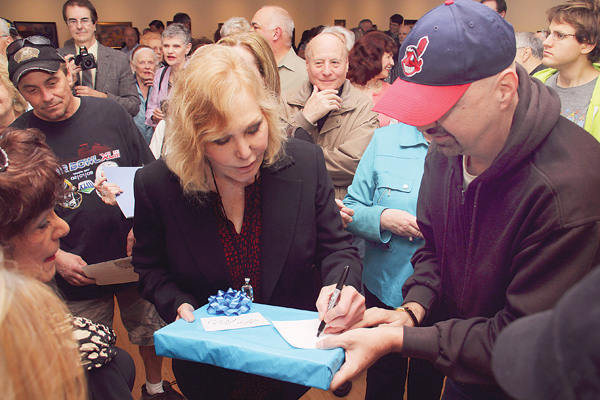BACK IN THE LIMELIGHT


Bob Simmons, right, of Youngstown gives a gift to Kim Novak during a reception at the Butler Institute of American Art in Youngstown on Sunday afternoon. The film legend’s art exhibition runs through June 29.
By Sean Barron
YOUNGSTOWN
Kim Novak’s artistic gift of combining in her paintings elements of Impressionism and Expressionism caused Dorothy Butler to express her positive impressions.
“I think she’s a fabulous, iconic blonde bombshell,” Butler said of Novak, a 1950s and ’60s film legend who retired from the movie industry for good in 1991 and devotes much of her time to art.
Nevertheless, Novak was the top box-office star for three-consecutive years in the 1950s.
Butler, 34, a Youngstown State University art-history major and fan of vintage films, was among a few hundred people who came to Sunday’s opening of Novak’s first solo art exhibition, which was at the Butler Institute of American Art, 524 Wick Ave., on the North Side.
The show runs through June 29.
Butler, a great-great-granddaughter of Joseph Butler, the museum’s founder, brought the film star, artist and animal lover a set of roses.
She also wore a 1950s-style outfit inspired by “Picnic,” a 1955 film starring Novak and William Holden that’s set in a rural Kansas town. The movie was nominated for six Academy Awards and won two.
One of 81-year-old Novak’s best-known roles was as Madeline in the 1958 Alfred Hitchcock psychological thriller “Vertigo.” She’s also appeared in numerous films alongside names such as Jimmy Stewart, Rita Hayworth, Judy Holliday, Fred MacMurray, Kirk Douglas and Jack Lemmon.
On Sunday, she appeared for a few hours at the museum and was received warmly by those who viewed her 27 pastel paintings of portraits, landscapes and interiors, all of which were inspired largely by nature and spirituality.
“I have always been influenced by life as it exists around me — touched by my past, the world of make-believe — and concerned about what affects life today and how it might affect and infect life tomorrow,” explained Novak, who lives in Oregon with her husband, Dr. Robert Malloy, an equine veterinarian. “Through the use of symbolism, I have found a way to express my passion for life.”
Such influences that also combine passion and sensitivity are evident in “Reflections,” a painting of an older dog that sees itself as a puppy in the mirror, which is colorfully symbolic of how Novak feels most people never see themselves as others perceive them.
Her recent work, “Transformation,” pays tribute to late South African President Nelson Mandela and his ability to bring together those of diverse races and backgrounds. Next to Mandela’s face is a series of profiles of people who appear to be singing in one unified voice.
One of her darker paintings, “Vertigo/Vortex of Delusion,” is based mainly on her role in the Hitchcock film and calls attention to a man’s obsession with unattainable love. Novak included a woman whose blond hair suddenly and wildly unravels in a whirlwind of colors that is a metaphor for the act of delusion.
Several works capture Novak’s love for animals and the outdoors, such as “Horse Heaven,” a tribute to the loss of animals throughout her life, as well as her attachment to them and the ability to move on. The centerpiece is Hunka Hunka, her Haflinger horse who she painted frolicking in a field of forget-me-nots.
Novak attended Wright Junior College in her native Chicago before winning two scholarships to the prestigious Art Institute of Chicago. Despite having suffered through two fires that destroyed many of her possessions, including her works of art, she resumed painting.
“I’m amazed by people who excel in multiple areas. She’s a great actress and a very fine visual artist,” said Dr. Louis A. Zona, the Butler’s director.
Novak was thrilled with the opportunity to exhibit her artwork at the Butler, especially after becoming aware of its reputation, Zona continued.
“She’s been very good to work with, a class act through this project,” added Kathy Earnhart, the museum’s public-relations director. “It’s all been positive.”
 43
43
